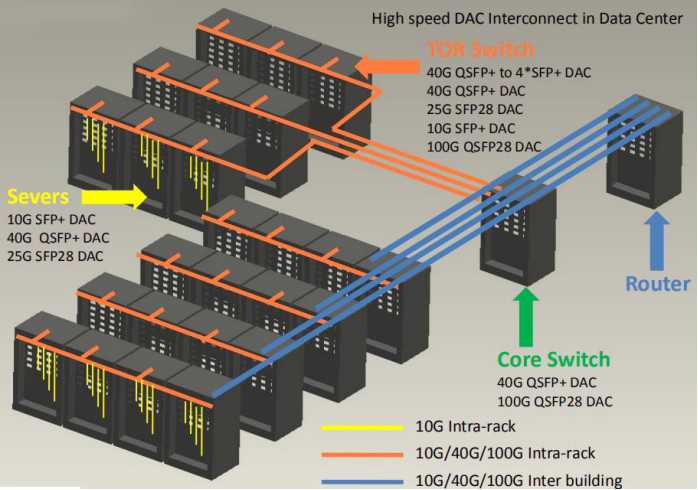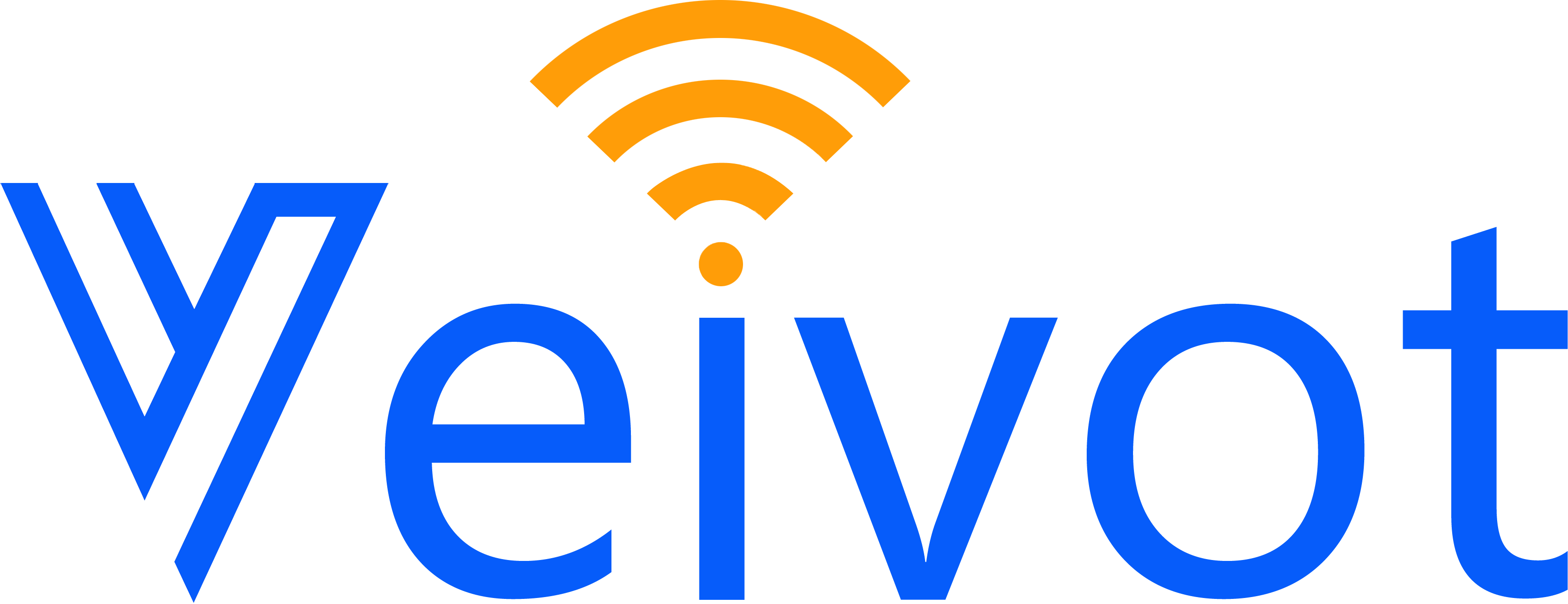
AOC (Active Optical Cable) and DAC (Direct Attach Cable) play crucial roles in cabling solutions that interconnect data centers and enterprise networks. AOC and DAC are both plug and play, allowing users to optimize existing networks without new fiber optic cabling. But the question is, under what circumstances should DAC or AOC cables be used? What are the advantages and disadvantages of these two types of network cables? The following sections of this article will provide a brief explanation of these issues.

DAC & AOC Cable Solutions for IDC High-Speed Interconnect
1. What do DAC and AOC have in common and how to tell them apart?
DAC and AOC are common cabling solutions for data networks, typically used for high-speed, highly reliable interconnection and transmission required by data centers, high-performance computers, and high-capacity storage devices. They have cable components with factory end transceivers at both ends, which are only connected to fixed ports. In addition, DAC and AOC cables can be manufactured in different lengths to support different transmission data rates, such as 10G SFP+ DAC/AOC cables, 25G SFP28 AOC cables, 40G DAC cables, 100G AOC cables, etc.
DAC cables are used to connect switches, servers, and storage within racks, while AOC cables are mainly used to connect switches, servers, and storage between different racks within the data center. In addition, DAC AOC cables differ from each other in the following aspects.
Passive DAC Cable | Active DAC Cable | Active AOC Cable | |
Reach | <7m | 7-15m | 100m |
Cable Types | Twinax Copper Cable | Twinax Copper Cable | Fiber Optical Ccable |
Power Consumption | <0.15w | 0.5-1w | >1w |
Weight | Heavy Weight | Heavy Weight | Light Weight |
Bend Radius | 24AWG=38mm | 24AWG=38mm | 25mm |
EMI | Weak | Weak | Strong |
Application | Top of Rack (ToR); | Top of Rack (ToR); | Top of Rack (ToR); |
2. Pros and Cons of DAC Cable
● Pros of Direct Attach Copper Cable
More cost-effective - generally speaking, the price of copper wire is much lower than that of optical fiber. The cost of passive copper cables is 2 to 5 times that of fiber optic cables of the same length. Therefore, using high-speed cables will also reduce the overall cabling cost of the data center.
Lower power consumption - High speed DACs have lower power consumption (almost zero power consumption) because passive cables do not require power. The power consumption of active copper cables is usually around 440mW. If you use directly connected copper cables instead of AOC fiber optic cables, you can save hundreds of thousands of kilowatts of electricity.
It is more durable - it is designed with a seamless connection between optical modules and optical cables, reducing costs and ensuring that optical ports are not exposed to dust and other pollutants. Therefore, DAC is not easily damaged.
● Cons of Direct Attach Copper Cable
One of the disadvantages of DAC cable is that it is heavier and bulkier than AOC cable and the shipping cost could be higher. In addition, it is more susceptible to the effect of electromagnetic interference and attenuation over longer distances due to the electrical signals transmitted between both ends.
Pros and Cons of AOC Cable
Pros of AOC
Lighter weight : A lighter weight active fiber optic cable consists of two optical transceivers and one fiber optic patch cable, which weighs only a quarter of a direct copper wire and has a volume of about half that of a copper wire.
Longer distances : Due to the better heat dissipation and smaller cable bending radius of AOC fiber in the cabling system of the computer room, AOC fiber with longer distances can provide a larger and longer transmission range, up to 100-300m.
More Reliable : Active optical cables are less susceptible to electromagnetic interference as they are a medium that can maintain their internal electrostatic field. The error rate of product transmission performance is also better, with an error rate of up to 10 ^ -15.
Cons of AOC
For high-density data center operators, AOC active optical cable is a more expensive wiring and assembly solution. In addition, if not properly managed, the durability of AOCs is poor because they are lighter and thinner, and if not handled properly, they are more susceptible to damage. The power consumption of AOC cables is higher than that of DAC, which results in lower operating costs for power consumption when using DAC options.
4. When do you Use DAC Cables?
According to the fabric architecture announced by Facebook, a server and Top-of-Rack switches(ToR) constitute the basic unit of the data center. Generally speaking, the distance between a ToR and a server NIC (Network Interface Card) is less than 5 meters. In this situation, DAC cable is more advantageous than AOC cables in the respect of cost, power consumption, and heat dispersion. Thus, DAC is a preferred option for IDC interconnect systems. Besides, on some special occasions, like 100G fan-out 4xSFP28 DAC is an alternative direct connection according to the user’s specific demand for the data connection.
5. When do you use AOC Cables?
Nevertheless, the transmission distance between ToRs and edge core switches is usually less than 100m, where Integrated circuits are deployed densely. Therefore, the active optical cable is a better cabling solution for data connection due to its merits of lightweight, small wire diameter, and manageable cabling maintenance. Since the data center has strict specifications on signal transmission, active optical cable is better than twin-ax DAC cable in signal integrity and optical coupling design, greatly reducing the errors in signal processing. Furthermore, the high-frequency EMI signal is processed within pluggable optical modules, AOC fiber cable has a better EMI performance than the DAC cable. Undoubtedly, AOC is your first option in the interconnection between switches and switches within short or intermediate reach.
Conclusion
It can be concluded that either active optical cables(AOC) or direct attach copper cables(DAC) are the better cabling solution for IDC networking according to different application demands. When there are few transmission requirements for the data center, the DAC cable solution is suggested as a better internet cable solution for the interconnection between the server and the switch within 5m/10m, while the AOC fiber solution is perfect for the interconnection between switches and the switches. By all means, it is unnecessary to analyze which is the better solution, that is AOC cable is always your first for performance is way much more important than cost if budget is never your concern.
Contact
Veivot Technology offer :
10G 10G SFP AOC cable, 25G SFP28 AOC cable, 40G AOC cable, 40G QSFP-4x10G SFP AOC cable, 56G SFP56 AOC cable, 100G QSFP28 AOC cable, 100G QSFP28-4x25G SFP28 AOC cable, 200G QSFP56 AOC cable, 400G QSFPDD AOC cable, 400G QSFPDD-4x100G QSFP28 AOC cable, etc.
10G 10G SFP AOC cable, 25G SFP28 AOC cable, 40G AOC cable, 40G QSFP-4x10G SFP AOC cable, 56G SFP56 AOC cable, 100G QSFP28 AOC cable, 100G QSFP28-4x25G SFP28 AOC cable, 200G QSFP56 AOC cable, 400G QSFPDD AOC cable, 400G QSFPDD-4x100G QSFP28 AOC cable, etc.
10G 10G SFP DAC cable, 25G SFP28 DAC cable, 40G DAC cable, 40G QSFP-4x10G SFP DAC cable, 56G SFP56 DAC cable, 100G QSFP28 DAC cable, 100G QSFP28-4x25G SFP28 DAC cable, 200G QSFP56 DAC cable, 200G QSFP56-2xQSFP28 100G DAC cable, 200G QSFP56-4xSFP56 50G DAC cable, 200G QSFPDD DAC cable, 400G QSFPDD DAC cable, 400G QSFPDD-4x100G QSFP28 DAC cable, 400G QSFPDD-8xSFP56 50G DAC cable, etc.
If you want to know more details about Veivot’s DAC or AOC cable, please contact sales@veiveot.com.





 INQUIRY
INQUIRY